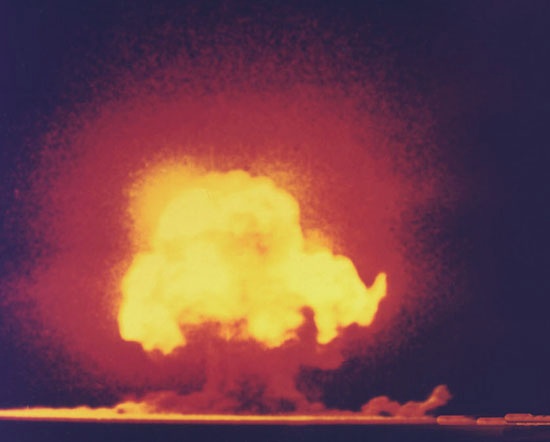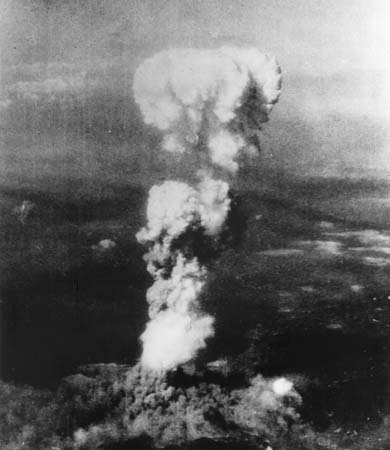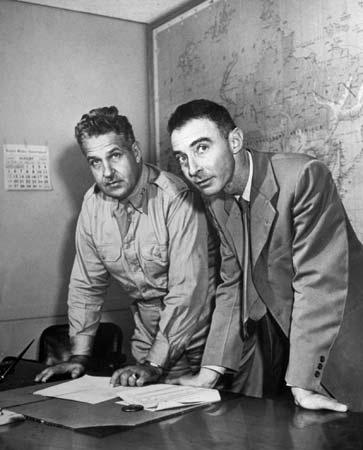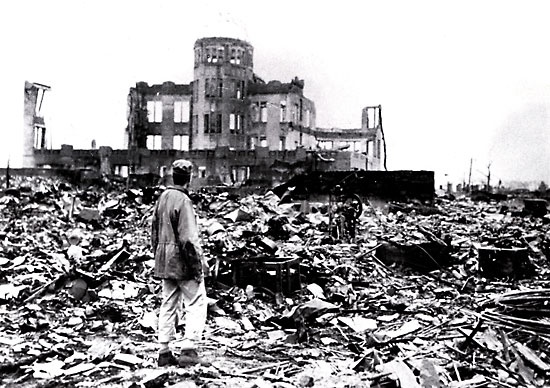atomic bomb
fission device
also called atom bomb
 weapon with great explosive power that results from the sudden release of energy upon the splitting (nuclear fission), or fission (binary fission), of the nuclei of such heavy elements as plutonium or uranium.
weapon with great explosive power that results from the sudden release of energy upon the splitting (nuclear fission), or fission (binary fission), of the nuclei of such heavy elements as plutonium or uranium.When a neutron strikes the nucleus of an atom of the isotopes uranium 235 or plutonium-239, it causes that nucleus to split into two fragments, each of which is a nucleus with about half the protons and neutrons of the original nucleus. In the process of splitting, a great amount of thermal energy, as well as gamma rays (gamma ray) and two or more neutrons, is released. Under certain conditions, the escaping neutrons strike and thus fission more of the surrounding uranium nuclei, which then emit more neutrons that split still more nuclei. This series of rapidly multiplying fissions culminates in a chain reaction in which nearly all the fissionable material is consumed, in the process generating the explosion of what is known as an atomic bomb.
Many isotopes of uranium can undergo fission, but uranium-235, which is found naturally at a ratio of about one part per every 139 parts of the isotope uranium-238, undergoes fission more readily and emits more neutrons per fission than other such isotopes. Plutonium-239 has these same qualities. These are the primary fissionable materials used in atomic bombs. A small amount of uranium-235, say 0.45 kg (1 pound), cannot undergo a chain reaction and is thus termed a subcritical mass; this is because, on average, the neutrons released by a fission are likely to leave the assembly without striking another nucleus and causing it to fission. If more uranium-235 is added to the assemblage, the chances that one of the released neutrons will cause another fission are increased, since the escaping neutrons must traverse more uranium nuclei and the chances are greater that one of them will bump into another nucleus and split it. At the point at which one of the neutrons produced by a fission will on average create another fission, critical mass has been achieved, and a chain reaction and thus an atomic explosion will result.
In practice, an assembly of fissionable material must be brought from a subcritical to a critical state extremely suddenly. One way this can be done is to bring two subcritical masses together, at which point their combined mass becomes a critical one. This can be practically achieved by using high explosives to shoot two subcritical slugs of fissionable material together in a hollow tube. A second method used is that of implosion, in which a core of fissionable material is suddenly compressed into a smaller size and thus a greater density; because it is denser, the nuclei are more tightly packed and the chances of an emitted neutron's striking a nucleus are increased. The core of an implosion-type atomic bomb consists of a sphere or a series of concentric shells of fissionable material surrounded by a jacket of high explosives, which, being simultaneously detonated, implode the fissionable material under enormous pressures into a denser mass that immediately achieves criticality. An important aid in achieving criticality is the use of a tamper; this is a jacket of beryllium oxide or some other substance surrounding the fissionable material and reflecting some of the escaping neutrons back into the fissionable material, where they can thus cause more fissions. In addition, “boosted fission” devices incorporate such fusionable materials as deuterium or tritium into the fission core. The fusionable material boosts the fission explosion by supplying a superabundance of neutrons.
 Fission releases an enormous amount of energy relative to the material involved. When completely fissioned, 1 kg (2.2 pounds) of uranium-235 releases the energy equivalently produced by 17,000 tons, or 17 kilotons, of TNT. The detonation of an atomic bomb releases enormous amounts of thermal energy, or heat, achieving temperatures of several million degrees in the exploding bomb itself. This thermal energy creates a large fireball, the heat of which can ignite ground fires that can incinerate an entire small city. Convection currents created by the explosion suck dust and other ground materials up into the fireball, creating the characteristic mushroom-shaped cloud of an atomic explosion. The detonation also immediately produces a strong shock wave that propagates outward from the blast to distances of several miles, gradually losing its force along the way. Such a blast wave can destroy buildings for several miles from the location of the burst. Large quantities of neutrons and gamma rays are also emitted; this lethal radiation decreases rapidly over 1.5 to 3 km (1 to 2 miles) from the burst. Materials vaporized in the fireball condense to fine particles, and this radioactive debris, referred to as fallout, is carried by the winds in the troposphere or stratosphere. The radioactive contaminants include such long-lived radioisotopes as strontium-90 and plutonium-239; even limited exposure to the fallout in the first few weeks after the explosion may be lethal, and any exposure increases the risk of developing cancer.
Fission releases an enormous amount of energy relative to the material involved. When completely fissioned, 1 kg (2.2 pounds) of uranium-235 releases the energy equivalently produced by 17,000 tons, or 17 kilotons, of TNT. The detonation of an atomic bomb releases enormous amounts of thermal energy, or heat, achieving temperatures of several million degrees in the exploding bomb itself. This thermal energy creates a large fireball, the heat of which can ignite ground fires that can incinerate an entire small city. Convection currents created by the explosion suck dust and other ground materials up into the fireball, creating the characteristic mushroom-shaped cloud of an atomic explosion. The detonation also immediately produces a strong shock wave that propagates outward from the blast to distances of several miles, gradually losing its force along the way. Such a blast wave can destroy buildings for several miles from the location of the burst. Large quantities of neutrons and gamma rays are also emitted; this lethal radiation decreases rapidly over 1.5 to 3 km (1 to 2 miles) from the burst. Materials vaporized in the fireball condense to fine particles, and this radioactive debris, referred to as fallout, is carried by the winds in the troposphere or stratosphere. The radioactive contaminants include such long-lived radioisotopes as strontium-90 and plutonium-239; even limited exposure to the fallout in the first few weeks after the explosion may be lethal, and any exposure increases the risk of developing cancer.
 The first atomic bomb was built in Los Alamos, N.M., during World War II under a program called the Manhattan Project. Los Alamos was approved as the site for the main atomic bomb scientific laboratory on Nov. 25, 1942, by Brig. Gen. Leslie R. Groves (Groves, Leslie Richard) and physicist J. Robert Oppenheimer (Oppenheimer, J. Robert) and was given the code name Project Y. One bomb, using plutonium, was successfully tested on July 16, 1945, at a site 193 km (120 miles) south of Albuquerque, N.M. The first atomic bomb to be used in warfare used uranium. It was dropped by the United States on Hiroshima, Japan, on Aug. 6, 1945. (See Sidebar: The decision to use the atomic bomb.) The explosion, which had the force of more than 15,000 tons of TNT, instantly and completely devastated 10 square km (4 square miles) of the heart of this city of 343,000 inhabitants. Of this number, 66,000 were killed immediately and 69,000 were injured; more than 67 percent of the city's structures were destroyed or damaged. The next atomic bomb to be exploded was of the plutonium type; it was dropped on Nagasaki on Aug. 9, 1945, producing a blast equal to 21,000 tons of TNT. The terrain and smaller size of Nagasaki reduced destruction of life and property, but 39,000 persons were killed and 25,000 injured; about 40 percent of the city's structures were destroyed or seriously damaged. The Japanese initiated surrender negotiations the next day.
The first atomic bomb was built in Los Alamos, N.M., during World War II under a program called the Manhattan Project. Los Alamos was approved as the site for the main atomic bomb scientific laboratory on Nov. 25, 1942, by Brig. Gen. Leslie R. Groves (Groves, Leslie Richard) and physicist J. Robert Oppenheimer (Oppenheimer, J. Robert) and was given the code name Project Y. One bomb, using plutonium, was successfully tested on July 16, 1945, at a site 193 km (120 miles) south of Albuquerque, N.M. The first atomic bomb to be used in warfare used uranium. It was dropped by the United States on Hiroshima, Japan, on Aug. 6, 1945. (See Sidebar: The decision to use the atomic bomb.) The explosion, which had the force of more than 15,000 tons of TNT, instantly and completely devastated 10 square km (4 square miles) of the heart of this city of 343,000 inhabitants. Of this number, 66,000 were killed immediately and 69,000 were injured; more than 67 percent of the city's structures were destroyed or damaged. The next atomic bomb to be exploded was of the plutonium type; it was dropped on Nagasaki on Aug. 9, 1945, producing a blast equal to 21,000 tons of TNT. The terrain and smaller size of Nagasaki reduced destruction of life and property, but 39,000 persons were killed and 25,000 injured; about 40 percent of the city's structures were destroyed or seriously damaged. The Japanese initiated surrender negotiations the next day.After the war, the United States conducted test explosions of atomic bombs in the Pacific at Enewetak (Eniwetok) atoll and in Nevada. In subsequent years, the Soviet Union (1949), Great Britain (1952), France (1960), China (1964), India (1974), and Pakistan (1998) tested fission weapons of their own. The great temperatures and pressures created by a fission explosion are also used to initiate fusion and thus detonate a thermonuclear bomb. See also nuclear weapon.
- Pematangsiantar
- Pemba Island
- Pemberton, John Clifford
- Pembroke
- Pembroke, Mary Herbert, countess of
- Pembroke, Richard FitzGilbert, 2nd Earl of
- Pembrokeshire
- Pembroke table
- Pembroke, William Herbert, 1st earl of, Baron Herbert of Cardiff
- Pembroke, William Marshal, 1st earl of
- pemphigus
- pen
- penal colony
- Penal Laws
- Penang
- Penates
- Pencho Petkov Slaveykov
- pencil
- pencil drawing
- pencil fish
- Penck, Albrecht
- Penck, Walther
- Penda
- pendant
- pendentive